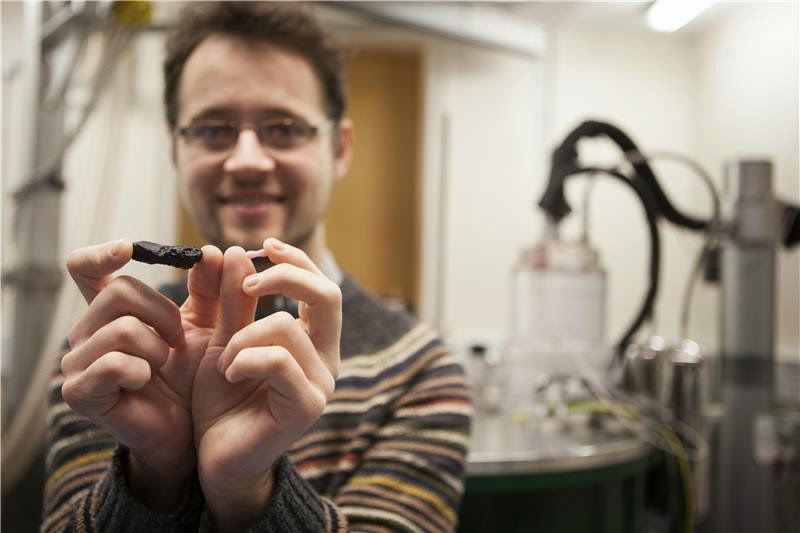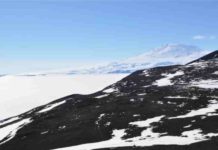
Using magnetic levitation to imitate weightlessness, researchers led by physicists at The University of Nottingham have manufactured solid wax models of splash form tektites. Dr Kyle Baldwin from the School of Physics and Astronomy, said: “These wax models provide the first direct experimental validation for numerical models of the equilibrium shapes of spinning droplets. This research is of importance to fundamental physics and also to study of tektite formation.”
Splash form tektites are tiny pieces of natural glass created out of spinning drops of molten rock flung from the earth during an extra-terrestrial impact — when the earth is hit by asteroids or comets. They come in a myriad of shapes — from dumbbell to doughnut — and the formation of these shapes has been the subject of scientific investigation for centuries. Using magnetic levitation to imitate weightlessness, researchers led by physicists at The University of Nottingham have manufactured solid wax models of these shapes. Dr Kyle Baldwin from the School of Physics and Astronomy, said: “These wax models provide the first direct experimental validation for numerical models of the equilibrium shapes of spinning droplets. This research is of importance to fundamental physics and also to study of tektite formation.”
Until now the shapes of rapidly spinning, highly deformed droplets have been derived entirely from numerical simulations. It is hoped this new experimental technique can be used to better reproduce and understand tektite formation. Their research — Artificial tektites: an experimental technique for capturing the shapes of spinning drops — funded by the Engineering and Physical Sciences Research Council (EPSRC) is published today in the online, open access journal Scientific Reports. The video can be seen here.
A droplet of liquid in space is spherical, but spin it and it forms all kinds of shapes from squashed balls to bone-shaped, depending on its rate of spin. Atomic nuclei, planets, including planet Earth, stars, and even black holes are deformed by their spin for the same reasons as a liquid droplet, as are tektites.
Just back from presenting his research at the 2014 American Geophysical Union’s Fall Meeting — the largest Earth and space science meeting in the world — Dr Kyle Baldwin said: “As you can imagine the creation of these tiny objects is difficult to reproduce in the lab. There aren’t many materials that can contain molten rock, and even then you need to spin and cool a single droplet of it simultaneously.”
These tiny glass objects are found mainly in Australasia, Central Europe, North America and the Ivory Coast — in areas associated with extra-terrestrial impacts.
When an asteroid hits the Earth, it creates a large, very hot, zone of impact material. Under very specific impact conditions, this rock melts and is splashed out in all directions. Exactly what these conditions are remains a topic of debate today. These droplets of splashed rock often have rotation imparted by the impact. The act of rotation changes the shape of the drop, depending on how fast it is spinning. It deforms them towards a more flattened sphere, and then eventually to a “dumb-bell” shape as it becomes unstable and pulls apart.
The drops of molten rock spin, change shape, but then crucially, due to the fact that they are cooling as they travel through the atmosphere, solidify into the shape that they formed. Some of these shapes then survive impact with the Earth and are later collected by teams of geologists and studied to examine both the type of rock that the asteroid impacted and the age of the impacted the onlinrock, to correlate with known impact sites and prehistoric extinction events, or find impact sites that have not yet been discovered.
Dr Baldwin said: “What I have done is realise that, using magnetic levitation and drops of wax, you can artificially recreate this process. By melting the wax on a hot plate, pipetting it into the magnetic field, spinning it up and then allowing it to cool, we can recreate some of the conditions that tektites are under as they form. We have primarily used this technique to measure the theoretical shapes of spinning drops, something that has never been done experimentally.”
Dr Baldwin entered this field of research as a postdoc. Working alongside Dr Richard Hill they began looking into levitating and spinning droplets. Using diamagnetic levitation to counteract the gravitational force on the droplet they were able to manufacture ‘artificial tektites’ from spinning molten wax droplets.
Dr Baldwin said: “You could effectively remove gravity by going into orbit, or you could take a parabolic flight but it wouldn’t be long enough. We use super conducting magnets to levitate liquids that are diamagnetic.”
Dr Hill, also from the School of Physics and Astronomy at The University of Nottingham, has been interested in the shapes formed by spinning droplets for some time. Together with Professor Laurence Eaves he published a paper in 2008 on the observation of ‘three-lobed’ or ‘triangular’ spinning droplets.
He said: “Kyle started working with me on this project just over two years ago. When he arrived, he had the brilliant idea of levitating molten wax and spinning it as it solidified, to capture its shape. We saw that the measurements could be used to validate numerical models of highly deformed spinning liquid droplets, relevant to nuclear physics and also to rapidly spinning astronomical objects.”
The research was carried out in collaboration with Professor Samuel Butler from the Department of Geological Sciences at the University of Saskatchewan, Canada. Professor Butler has previously published papers on simulating tektite formation. He provided supporting simulation evidence that the shapes created by Dr Baldwin were the true equilibrium shapes of spinning liquid droplets allowed them to compare their results, sophisticated modern numerical simulations and calculations from literature.
Reference:
Kyle A. Baldwin, Samuel L. Butler, Richard J. A. Hill. Artificial tektites: an experimental technique for capturing the shapes of spinning drops. Scientific Reports, 2015; 5: 7660 DOI: 10.1038/srep07660
Note : The above story is based on materials provided by University of Nottingham.









